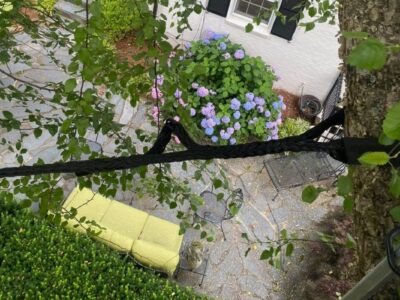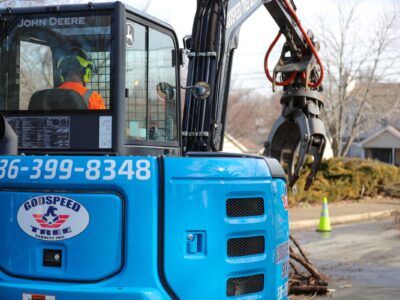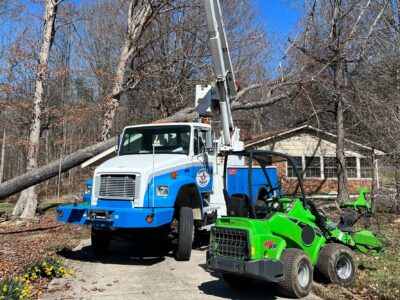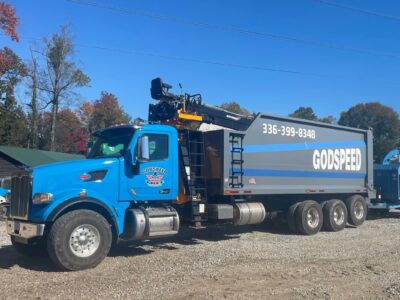5 Common Insect Pests Killing Winston-Salem Trees
July 18, 2024
Don’t let bugs destroy Winston-Salem’s trees! This guide identifies common insect pests damaging trees in our area, like emerald ash borer and spongy moth, how to recognize signs of infestation, and what you can do to protect or treat your trees.
Have you noticed your once vibrant trees looking a little lackluster lately? Perhaps their leaves are turning brown and falling prematurely, or there’s a sudden uptick in strange insects crawling on the branches or clinging to the trunk. These are likely signs of one or more of the common tree pests wreaking havoc on Winston-Salem’s trees.
Living in Winston-Salem, NC, we are lucky to have a wide variety of vibrant trees that grace our streets, parks, and backyards. From spring-blooming kousa dogwoods to the fiery red maples blazing in fall, our trees offer a breathtaking display of beauty throughout the changing seasons. But all trees are vulnerable to insect pests. The key is to recognize when a tree is under attack and know what to do about it.
In This Article
- Learn about common tree pests like spongy moths, elm zigzag sawflies, southern pine beetles, emerald ash borers, and spotted lanternflies, and the damage they cause to Winston-Salem’s trees.
- Discover how proactive tree care like pruning and fertilization can strengthen your trees and make them more resistant to pest infestations.
- Find out why consulting a certified arborist is important in protecting your trees’ health in an ever-changing environment.
Common Signs of Insect Infestations in Trees
Unfortunately, trees can’t tell us when they’re under attack. That’s why we must pay close attention to other telltale signs that our trees are suffering from an insect infestation, such as:
- Leaf Discoloration: Healthy leaves are a vibrant green (on most trees), so any significant change in color can be a warning sign. Look for yellowing, browning, or even black spots.
- Leaves Falling Prematurely: It’s normal for deciduous trees to lose their leaves in the fall. However, if your tree is losing its leaves outside of this season, we need to take a closer look. Trees under significant stress will drop leaves to conserve energy and protect themselves. This allows them to focus their resources on more vital parts like the trunk and roots.
- Large Number of Insects: Pay close attention to the number of insects on your tree. If there is an abnormally high amount concentrated in specific areas like the trunk, branches, or underside of leaves, you should contact a local certified arborist as soon as possible to keep the insects from spreading to nearby trees.
- Damaged Bark: Bark acts as a protective barrier for the tree and comes in a variety of textures depending on the type of tree. However, a tree with a pest infestation may have holes in the bark with no common pattern, peeling or splitting bark, cankers (sunken, oozing areas), or other signs of damage.
5 Tree Pests You Should Keep an Eye Out for in Winston-Salem
Our trees are full of all kinds of creatures! Most are harmless, and some are even beneficial to the health of our trees. However, there are a few specific insect pests that can cause big problems.
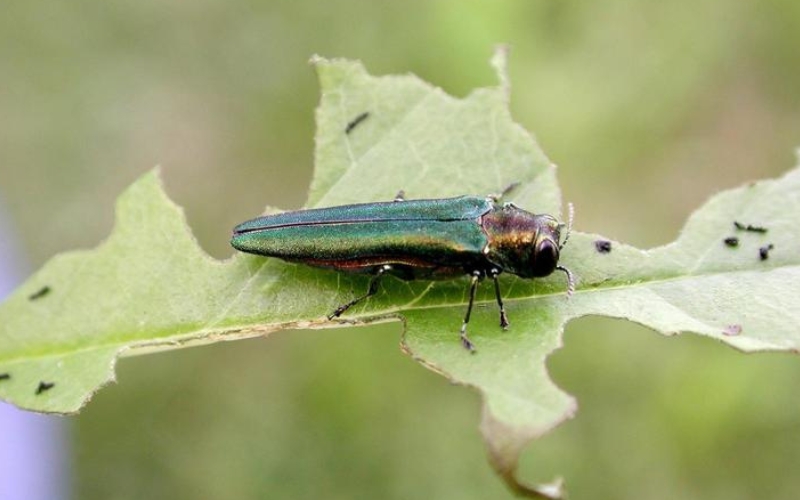
Although it may look pretty with its shiny, metallic green wings, the emerald ash borer can quickly kill an ash tree. Image courtesy of Debbie Miller, USDA Forest Service, Bugwood.org
1. Emerald Ash Borer
The emerald ash borer (EAB) is an invasive wood-boring beetle from Asia that is responsible for the death and decline of tens of millions of ash trees in North America. Emerald ash borer adults are about half an inch long with a metallic green body and coppery-red abdomen.
They lay their eggs in the bark crevices of ash trees, and when the eggs hatch, the larvae burrow into the tree to feed. This feeding damages the tree by disrupting its ability to transport water and nutrients, leading to a tree’s death within a few years of infestation.
Emerald Ash Borer Treatment
Unfortunately, there’s no cure for an established emerald ash borer infestation. The damage done is irreversible.
However, a certified arborist can provide preventive tree injection treatments that insert an insecticide directly into the tree’s vascular system. These treatments must be applied every one to two years, and are only effective if injected before the tree is infested or before more than 30% of the tree canopy has been killed.
What to Do if you Have Ash Trees in Your Yard
Because there’s no cure for the damage caused by EAB, have a certified arborist preventively treat any valuable ash trees on your property to protect them from infestation. And if any of your ash trees look sick, call your local arborist right away to inspect the tree and hopefully prevent EAB from spreading to other ash trees in Winston-Salem.
If a tree infested with EAB cannot be saved, it should be removed as soon as possible to stop the spread and eliminate the hazard of a dead ash tree.
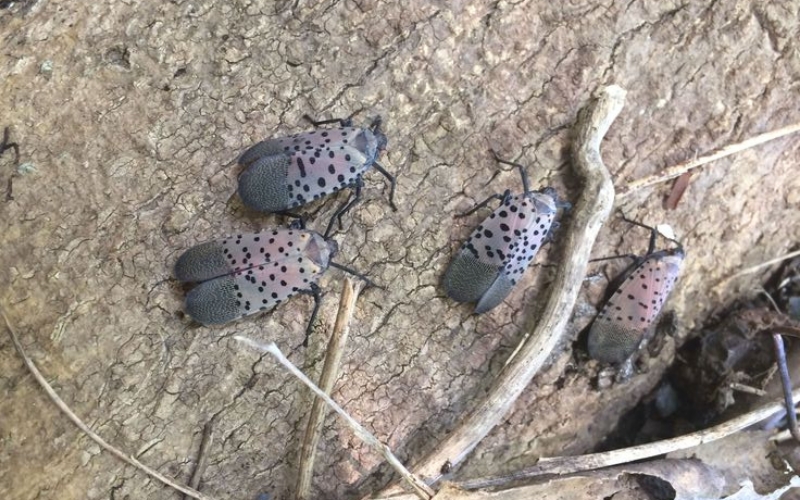
If you see one of these colorful flying pests, experts recommend killing it to help protect our trees and agricultural crops. Image courtesy of Sara Lalk, Clemson University, Bugwood.org
2. Spotted Lanternfly
The spotted lanternfly is another invasive insect native to Asia. Although they’re primarily a threat to grapevines, spotted lanternflies also feed on more than 100 species of plants, fruit trees, and native trees.
This insect is brightly colored with grey forewings, red hind wings with black spots, and a black spotted head. They feed on trees by sucking sap with their piercing mouthparts, disrupting the transportation of nutrients, and weakening the tree over time.
As if that isn’t enough, spotted lanternflies also leave behind a sugary substance called honeydew. This sticky mess attracts other insects (such as ants and wasps) and promotes the growth of sooty mold, a black fungus that blocks sunlight from reaching the leaves.
Spotted Lanternfly Treatment
Although not nearly as detrimental as emerald ash borers, the earlier we detect these pests, the easier it is to control them. Squashing spotted lanternflies and scaping off egg masses effectively reduces their population on small trees. But the most effective solution is having a certified arborist apply an insecticide that targets spotted lanternflies while minimizing harm to beneficial insects.
These flying pests also have a favorite host tree, commonly called Tree of Heaven. If spotted lanternflies have become a nuisance in your neighborhood, consider removing any of these trees on your property to reduce the number of pests attracted to your yard.
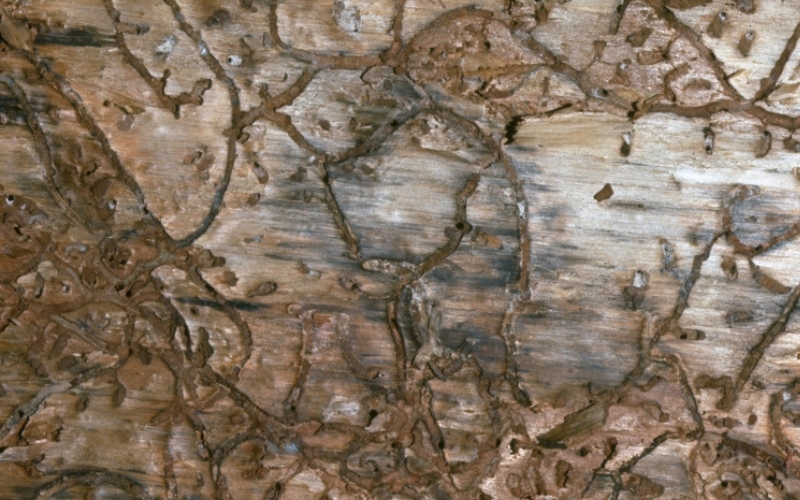
Southern pine beetle damage occurs primarily beneath the bark where it’s difficult to spot. Image courtesy of USDA Forest Service – Region 8 – Southern, USDA Forest Service, Bugwood.org
3. Southern Pine Beetle
Because southern pine beetles are only about the size of a grain of rice, they can be tricky to spot. You can keep an eye out for pitch tubes on your tree, though. These sticky blobs, about the size of a piece of popcorn, are created when the beetles burrow into the tree and expel excess sap.
The beetles feed on phloem tissue just under the bark and typically attack the middle and upper trunk first. Females emit a pheromone that attracts even more beetles to the tree, and from there, they can spread to other nearby stressed but otherwise healthy trees.
Southern Pine Beetle Treatment
As of now, there are no known effective treatments for these pests once a tree is infested. Spraying a tree with insecticides has shown very little effect since the beetles reside in the inner bark.
Instead, most tree care experts are focusing their efforts on prevention and stopping the spread of the southern pine beetle with preventive tree injections. To ensure the pine trees on your property remain healthy, speak with a knowledgeable arborist about preventive pine beetle treatments.
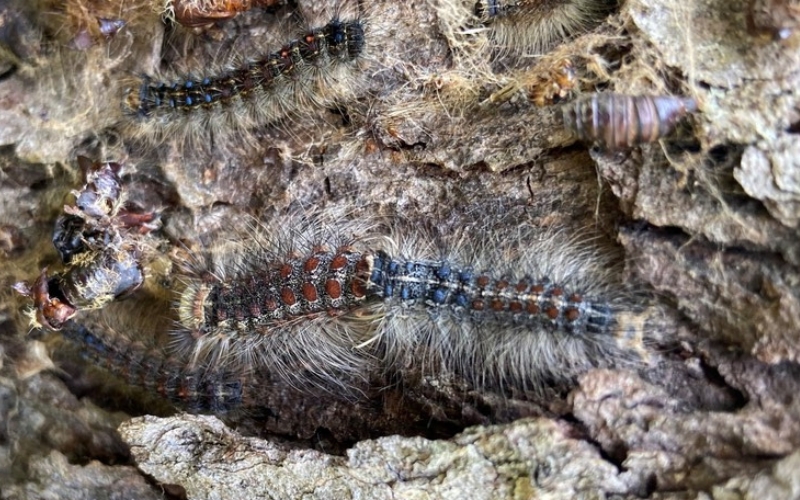
Spongy moth larvae (caterpillars) have distinctive red and blue dots running down their back. Image courtesy of Bill McNee, Wisconsin Dept of Natural Resources, Bugwood.org
4. Spongy Moth
Once known as the gypsy moth, spongy moths can be a real headache for our city’s trees. These hairy caterpillars have a distinct look – pairs of blue dots followed by pairs of red dots running down their backs. They are notorious for munching on leaves and have devoured a whopping 75 million acres of forest since 1970!
Spongy moths are a problem not only because they feed on more than 300 different species of trees, but their hair and droppings can cause itchy rashes and other unpleasant allergic reactions in people and pets.
Spongy Moth Treatment
If you notice any spongy moths, the sooner you call the experts, the better. When you contact a certified arborist at the first sign of a spongy moth infestation, they can assess the severity of the situation and recommend the best course of treatment. This might include:
- Spraying organic insecticides like Bacillus thuringiensis (Bt) that prevent the caterpillars from maturing.
- Removing the egg masses to reduce the number of caterpillars that emerge.
- Applying insecticides to your trees that specifically target spongy moths.
How North Carolina is Helping Prevent the Spread of Spongy Moth
North Carolina has teamed up with the USDA Forest Service to implement a program called “Slow the Spread.” This program uses a special aerial treatment that disrupts the mating habits of spongy moths, helping to control their population and prevent them from spreading to new areas.
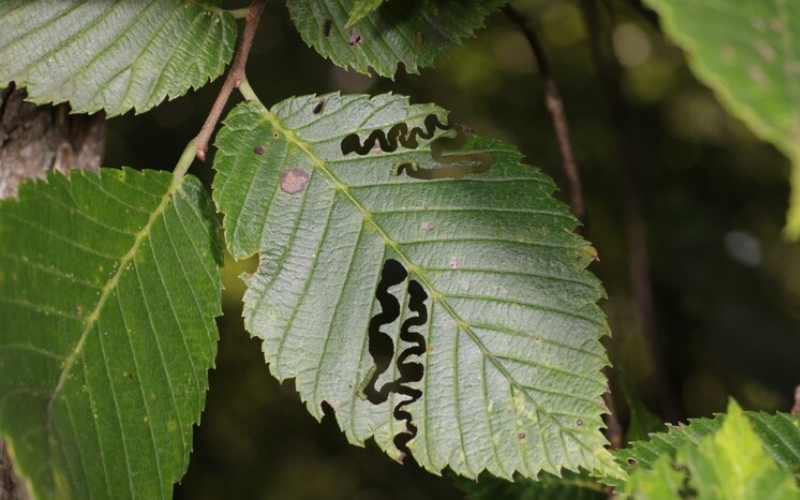
The elm zigzag sawfly larva eats the tender parts of elm leaves between the veins, creating a zigzag, maze-like pattern. Image courtesy of Tom Macy, Ohio DNR Division of Forestry, Bugwood.org
5. Elm Zigzag Sawfly
Like the spongy moth, an adult elm zigzag sawfly isn’t of greatest concern – it’s the larvae that cause the most trouble. Elm zigzag sawfly larvae are light green caterpillars with black heads, and instead of devouring leaves whole, they munch out the soft tissue between the veins. What’s left is a zigzag pattern that resembles a maze.
The elm zigzag sawfly population can grow quickly, and although they are small insects, outbreaks can defoliate large elm trees. The good news is that defoliated trees can eventually recover. However, heavily defoliated trees or reoccurring infestations can further weaken or stress the elm tree, making them more susceptible to other fatal tree diseases, pests, and death.
Elm Zigzag Sawfly Treatment
Thankfully, elm zigzag sawfly infestations are usually manageable with the right help. A certified arborist can spray your tree with a targeted insecticide that is ingested by the larvae as they munch on the tree’s leaves. This type of spraying requires special pressurized tools to thoroughly coat all parts of the tree, including the upper canopy (in other words, it’s not a DIY treatment).
Arborists can also recommend tree care services that will help prevent these outbreaks from occurring in the future.
Protect Your Trees from Common Insect Pests – Call Godspeed Tree Service
Environmental changes can influence the types of pests we see in Winston-Salem, as well as the severity of the infestations. So, how can you protect your trees in an ever-changing environment? The answer is simple – year-round tree care services from Godspeed Tree Service. We can help you:
- Stay Aware: By staying informed about emerging pest threats and the latest best practices, Godspeed can recommend preventative measures to keep your trees healthy.
- Develop a Customized Plan: Each tree is unique. That’s why we assess your trees’ specific needs and recommend a personalized plan that may include proper pruning, targeted fertilization, and integrated pest management strategies.
- Catch Problems Early: Regular inspections by Godspeed’s certified arborists can identify pest issues early on, before they cause significant damage.
Our trees are worth saving! Call us today at 336-399-8348 to schedule a consultation with a certified arborist or fill out our form online to request a quote for an inspection and pest management services.

Godspeed Tree Service
Owned and operated with high standards and consistent reliability by Bobby Gates, Godspeed Tree Service has earned the trust of the North Carolina Triad community over the course of more than 25 years in business. With a strong emphasis on safety, conscientious training, and accommodating the needs of each client, you can't go wrong by hiring Godspeed for any of your tree service needs!
